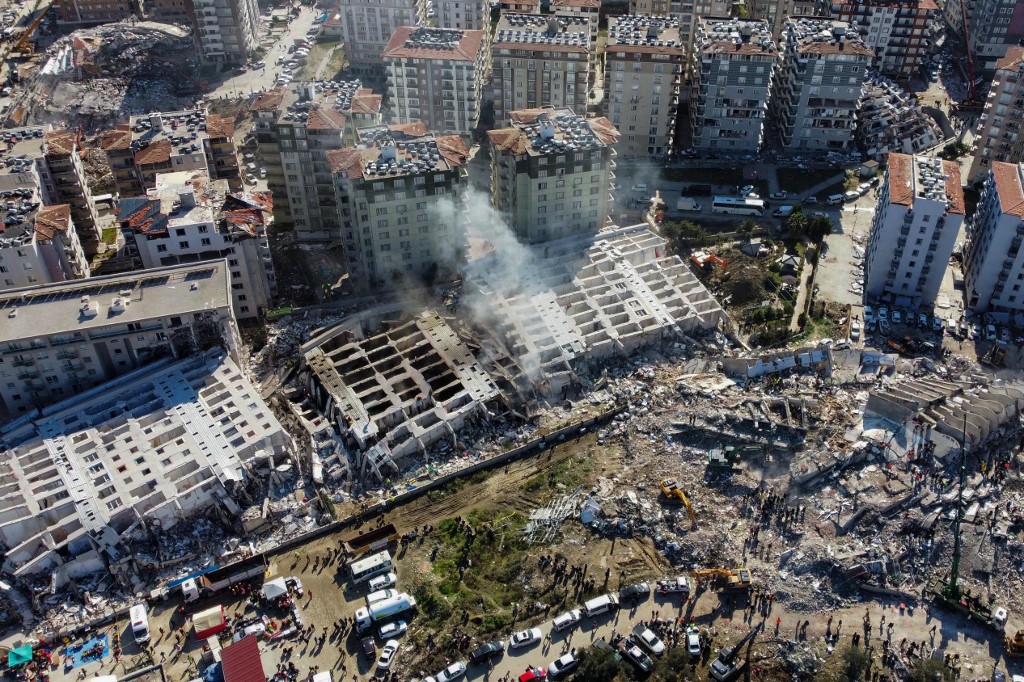The excavator tore into the remnants of the damaged building in southeast Turkey, bringing it crashing down into a cloud of dust — the latest menace facing survivors of the deadly February earthquakes that ravaged the region.
Extending to the horizon, a cocoon of fine grey dust envelops the city of Samandağ in the south of Hatay province, devastated by the Feb. 6 earthquakes that killed more than 55,000 people and laid waste to parts of Turkey and Syria.
“We survived the earthquakes, but this dust will kill us,” Michel Atik, founder and president of the Samandağ Environmental Protection Association, said with a sigh.
“We are going to die of respiratory diseases and lung cancer with all these hazardous materials.”
Five months after the quake, the scale of cleanup and reconstruction is enormous, with the government estimating that nearly 2.6 million buildings have been destroyed.
According to the UN Environment Program, some 210 million tons of rubble must be disposed of.
By comparison, some 1.8 million tons of rubble had to be hauled away after the Sept. 11, 2001 attacks in New York City that brought down the World Trade Center skyscrapers.
Environmental activists and local residents worry that in the rush to clean up and rebuild, crucial safety measures are being ignored, with potentially adverse effects on the health of local residents, the environment and the economy.
Landfills
The landfill near Samandağ is one of several that have been set up in this province bordering Syria. It lies next to the Mediterranean and the Milleyha natural bird reserve, also a nesting site for endangered green sea turtles.
Another landfill, in the Antakya region, lies near a valley of olive trees at the foot of the Nur Mountains. With olive oil the primary source of income in the province, there are fears that the dump could harm the trees.
“They don’t even hose it down,” said Çağdaş Can, 33, an environmental activist with the Reconstruct group, as he watched trucks filled with debris leave Samandağ toward the huge open-air landfill that lies next to one of Turkey’s longest beaches.
“There were other possible sites … But the companies that won the tenders [for clearing] chose here to save fuel,” said Can.
“All they care about it recovering the iron and the metal,” he said.
“Nobody wears a mask. The demolition sites are not covered or hosed down, and neither are the holds of the trucks, as required by law,” he said.
Can said his environmental organization had tried to stop the trucks by forming human chains, “but the police intervened. Eighteen people were arrested, and I had my collarbone broken,” he said.
The exhausted local population, faced with myriad problems after the quake, has not mobilized, he said, but they are as worried as the conservationists about the impact of the cleanup.
Hidden hazards
“The children are the first to be affected, they cough a lot, so do we. As soon as it’s windy, everything is covered in dust,” said Mithat Hoca, 64, who sells vegetables at a stall in central Samandağ.
“We have to cover everything,” said Mehmet Yazıcı, a 61-year-old retiree who passed by on a scooter. “We wipe the table 15 to 20 times a day. You have to do it every half hour.”
Ali Kanatlı, a doctor in Antakya, some 26 kilometers (16 miles) away from Samandağ, has already seen cases of “conjunctivitis, allergies, asthma, bronchitis.”
But above all, he worries about the long-term effects, like an increase in cancers that the hazardous materials in the rubble and dust could cause in the region.
Turkey did not ban asbestos until 2013, and most of the buildings affected by the quakes are older, he said.
“In addition to asbestos, we have lead in paint and heavy metals including mercury in electronic equipment such as televisions and household appliances,” he said.
© Agence France-Presse

